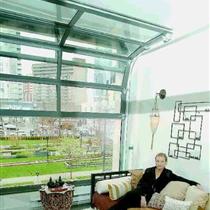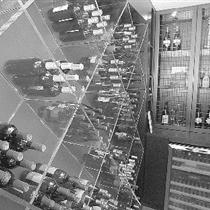John C. Ryan
Sun
Archive for April, 2006
Vancouver’s top city planners retiring (Larry Beasley, Ann McAfee)
Tuesday, April 18th, 2006Restaurant designs gain elegance as city becomes more cosmopolitan
Peter Wilson
Sun
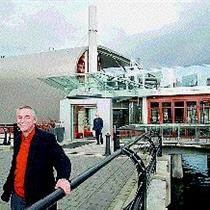
Architect Jon Sunderland (foreground), and Bob Lindsay, owner of Lift Bar Grill, which reflects city restaurants’ new design trend. Photograph by : Glenn Baglo, Vancouver Sun
The weather outside the trendy Lift Bar Grill, just behind the Bayshore on Coal Harbour, is distinctly undecided. Sometimes it’s cloudy, and then it moves into sun and back into cloud again.
Which makes Vancouver-based architect Jon Sunderland’s point.
“With Lift we had to emphasize the warmth and the light inside as well,” said Sunderland a partner in SmartDesign Group, which designed Lift for owner Bob Lindsay. “In Vancouver, you can’t rest your laurels on the view when it isn’t there.”
At the same time, when the weather cooperates, all the windows in Lift can be removed to make it into what Sunderland — who designs restaurants all around the world — calls a convertible.
“It’s like taking the top down in your car, and it’s amazing,” said Sunderland. “The character changes and it has a totally different personality.”
But, windows in or out, Lift fits into what Sunderland sees as a main trend in restaurant design in Vancouver.
“Vancouver is a unique city with all the condominiums and the urban lifestyle because we have a downtown that works,” said Sunderland. “So the trend here is toward more social interaction.”
And that interaction is, logically enough, produced by designing restaurants that have a similar feel to the condominiums in which people already live.
“While the West Coast has a certain character — and that’s a very warm, rustic wood-type character — we took a more contemporary look with Lift,” said Sunderland. “And that concept was to give a real residential feel, as if you were over at someone’s condominium and having a kitchen party.”
Among the elements that make up Lift is a cocktail bar that becomes a food bar where people eat.
“And what that bar does for us is improves interaction on a Friday or a Saturday night so that people have more of a tendency to talk to one another or even to total strangers.”
Lindsay said that visitors from everywhere like the feel of Lift.
“We’ve had guys sitting up at the bar that travel the world and they take me aside and they say, Bob, you know what. There’s nothing in New York that you don’t have out here.”
The upper deck of Lift has an open fire pit with eight chairs around it, and that too, is part of a trend towards open outdoor spaces — even though in Vancouver the ambience has to be modified during rainy weather.
“On our deck we have 10 by 10-foot umbrellas that open up and hook together,” said Lindsay.
Interior general contractor Ron Gerrard of Herron Construction, who has built such restaurants as Aqua Riva, Salmon House on the Hill, Wildflower in the Chateau Whistler along with a number of White Spots and Earls, came into the business in Vancouver some 20 years ago.
“When we first started, everybody was going away from those dark, dingy style restaurants that the Keg was famous for,” said Gerrard. “And one of the innovators was a designer called David Vance who came up with the Earl’s concept, which was all open plan where you wanted to be seen and you wanted to feel the people.”
Other restaurants followed suit like the Cactus Club and Red Robin and Joey Tomatoes, said Gerrard.
“Then we started to grow and become more aware of what was going on globally and we started to grow up as a city and recognize fine dining,” said Gerr-ard.
Now, he added, with restaurants that wouldn’t be out of place in New York, London or Paris, the city is going away from cookie-cutter style design and creating a unique environment to match the cuisine.
“Now they go for an emphasis on material and workmanship,” said Gerrard.
“Lift just opened in Coal Harbour and of course there’s Aqua Riva and West and Blue Water Cafe. And those restaurants have popped up over the last few years and they’re successful and they’re thriving and they’ve succeeded.”
Gerrard said that their common thread is one of quiet sophistication that matches the food.
© The Vancouver Sun 2006
Vancouvers top restaurants include Bishops, Lift, Monks business sizzles
Tuesday, April 18th, 2006Annual receipts reach a record of more than $6 billion in 2004
Peter Wilson, Vancouver Sun
Sun
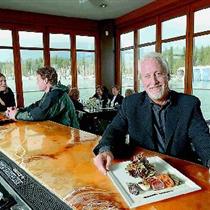
Bob Lindsay owns Lift Bar and Grill, Monk McQueens in Vancouver and Monk’s Grill in Whistler. Photograph by : Glenn Baglo, Vancouver Sun
When it comes to eating out, British Columbia families lead the way — spending, on average, $1,727 each year in restaurants or 24.2 per cent of their annual food budget.
And that puts us ahead of everyone else in the country in downing food and drink outside our homes.
So it’s no wonder that BC Stats reported recently that, as we ready ourselves for the 2010 Winter Olympics, the restaurant industry is looking good.
In 2004 BC’s restaurant, caterer and tavern receipts reached an annual record of more than $6 billion, an 18.2 per cent jump from 2000, and much better than the 12.6 per cent national average hike.
And the outlook appears to be good across the board from fast food to fine dining.
However, operating a restaurant is no sure way to riches, or even a bare living and it’s fraught with danger, with even long time successful operators offering cautions to those who want to make it big by tickling the public’s palate.,
When restaurant legend John Bishop of Bishop’s is asked about going it alone in the business he’s a man of few words.
“I say ‘don’t do it.'” Bishop said. “Say I’ve got a young staffer and we’ve had a pretty busy night I say ‘don’t do it.'”
Not that they pay attention.
Said Bishop: “I can’t tell you how many people have come through my place, that have gone on to open a restaurant and be successful and I’ve probably said ‘don’t do it’ to all of them.”
Even, so people still open restaurants and this has made Vancouver, at least, one of the cheapest major culinary cities in which to eat, said Geoffrey Howes of Toseki Entertainment which operates Aqua Riva and The Salmon House on the Hill.
“People ask how come we have the best prices and the best value in North America?” Howes said. “If you go to Toronto, San Francisco, New York or anywhere else the prices way more than here.
“And the overall quality now is dramatically better in some cases than those cities. The reason for that is pure and simple, competition.”
Howes said that the good side of competition is that the consumer gets the best possible and it forces innovation because people are constantly looking for a new niche to be better than somewhere else.
“I don’t believe we would see that kind of innovation in this city if it wasn’t for the fact that the business is so competitive that you’re constantly trying to reinvent the wheel to do a better job so people will come to your restaurant,” said Howes.
He contrasted the situation
in Vancouver with that in San Francisco, where there are restrictions on the number of restaurant licences issued.
All you have to open a restaurant here is to get a liquor licence and get the appropriate health permits, said Howes.
Vancouver restaurateur Bob Lindsay, who operates Lift, Monk McQueens and Monk’s Grill in Whistler said that most restaurants fail because of cash flow problems and a lot of that is because of the seasonal nature of tourism.
“May through September we’re all hugely busy and then October through April we’re all going after the same limited market,” said Lindsay. “I don’t know how many restaurants there are in Vancouver now, but it’s got to be over 2,000.”
When restaurants get into trouble, said Lindsay, is in the low volume months.
“It’s not that they’re necessarily losing money on an annual basis, but they just don’t have the cash flow to keep up with what they need to put out to their suppliers.”
The smallest restaurants are usually what are known as ma and pa operations.
“And that’s where you work seven days a week as the proprietor,” said Lindsay. “You’re the waiter or the dishwasher or the cook and you might make $60,000 a year. I call that subsistence restauraturing.
By contrast, Lindsay’s restaurants take in a combined income of $15 million a year.
“We work on volume and trying to keep our bottom line as healthy as we can,” Lindsay said. “There are just a million things that can erode your bottom line in the restaurant industry, the biggest one being labour.”
It’s not just the ma and pa operations that face major problems. Recently a restaurant with a terrific reputation, which won several awards, Bis Moreno on Hornby Street went out of business after eight months of seeming huge success.
And Bud Kanke, who now operates Joe Fortes and started up 10 restaurants in Vancouver including The Cannery and The Fish House in Stanley Park, remembers hitting hard times in the early ’80s.
“In 1980 my net worth was so far minus below zero I had to build it all back up again,” said Kanke. “It just went. It was gone. I always say I do it one salmon steak at a time.”
Howes said there is a statistic often bandied about that 80 per cent of restaurants go bankrupt or don’t make any money over their first two years, but that this is unprovable.
“You can’t measure that easily by the bankruptcies because what traditionally happens is that a restaurant will open, they’ll be underfunded financially, they won’t have enough cash flow and they won’t get the sales that they’ve quite predicted. Or their expenses could be way too high because they don’t understand the business.”
Then what traditionally happens, said Howes, is that they hang in, just surviving and then, perhaps, the restaurant gets sold to someone else.
With that said, however, there is always the chance that the restaurant will make it big and cash in on all the hard work and hours of intense dedication.
Just ask John Bishop who opened his namesake restaurant on Dec. 12, 1985.
“I thought that maybe, if I thought about it at all, that we might get five years out of it,” said Bishop.
PROFILE OF THE BRITISH COLUMBIA RESTAURANT INDUSTRY:
– Annual revenues: More than $6 billion a year.
– Number of restaurants: More than 9,500.
– Employees in restaurants and drinking places: Close to 118,000.
– Percentage of the workforce: 8.7.
– Salaries wages and benefits: More than $1.7 billion.
– Average annual amount British Columbia households spend in restaurants per year, as of 2005: $1,727 (significantly higher than the national average of $1,519 and a whopping 37.2 per cent boost from 2000).
– Percentage of total household expenditure on food spent in restaurants: 24.2 per cent, the highest in Canada.
— Based on the most recent figures available from Statistics Canada and BC Stats.
© The Vancouver Sun 2006
City hotel pairs up with B.C. wineries
Tuesday, April 18th, 2006Boutique hotel for wine lovers
John Bermingham
Province
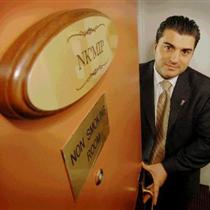
Alex Limongelli, of the Executive Hotel Vintage Park on Howe Street in Vancouver, says the focus is to educated guests about B.C. wineries. Photograph by : Wayne Leidenfrost, The Province
The glasses runneth over at the Executive Hotel Vintage Park in Vancouver.
B.C.’s first wine-themed hotel has launched a unique partnership with 43 B.C. wineries, offering a boutique hotel setting for wine lovers.
At the hotel, 40 of the wineries have wine-designated rooms, with their own brass plaque and artwork.
B.C. wines are promoted at hotel wine-tasting events every evening, with the noble grapes being paired with meals at the hotel restaurant.
“Our focus at the hotel is to educate people about the different wineries in B.C.,” said Alex Limongelli, the hotel’s general manager, during a tour of the hotel yesterday.
Executive Hotel Vintage Park is also finalizing packages for wine tourists who want a quick tour of B.C. wineries.
The hotel will offer guests a rental car, map and picnic basket (with a suitable wine selection) for those who want to visit B.C. wineries in the Okanagan.
“It’s more like an individual journey through the B.C. wineries,” said Limongelli. “There’s a lot of smaller B.C. wineries that go un-noticed. So we want to educate people.”
Farida Sayani, owner of the B.C.-owned Executive Hotel chain, said the program follows on the success of its wine-themed hotel in San Francisco, which has partnered with Napa Valley wineries for years.
“B.C. wine is getting so popular throughout the world,” said Sayani.
“Making this a wine-themed hotel and working with the wineries so closely, we are able to actually promote B.C. wines to tourists and our customers.”
Sayani said Mission Hill winery is the latest to come on-board.
Angela Lively of Vincor International Inc., which owns numerous wineries including Jackson-Triggs, Sumac Ridge and Hawthorn Mountain, called it a ‘win-win’ partnership.
“It’s exposure for our brands,” said Lively. “We have a partnership with the hotel where they sell a lot of our wines. It’s to support them in their concept as well.
“We’re helping them support their theme and they’re helping us support our brands.”
Jeff McDonald of the B.C. Wine Institute in Kelowna, said wineries are keen to get into wine tourism.
“The industry thinks it’s great that partnerships are emerging like this,” he said .
Sales of B.C. wine grew from $100 million in 2004 to $131 million last year, and have an annual growth rate of 20 per cent.
“The growth in the wine industry has been explosive,” he said. “Hotels and restaurants that want to offer quality experiences want to feature B.C. VQA wines as part of the experience they offer.”
McDonald said B.C.’s wineries are currently developing a strategic plan for wine tourism.
© The Vancouver Province 2006
Local firm’s travel website gets top marks
Saturday, April 15th, 2006MYTRIPJOURNAL.COM I Forbes magazine praises site, which lets users post blogs to record their trips
Brian Morton
Sun
A Vancouver-based Internet company that allows travellers to post online blogs in some of the world’s most remote locations has been listed by Forbes magazine as one of the best travel websites anywhere.
MyTripJournal.com, which provides travellers with a Web journal to record their trips and stay in touch with friends and family, was started two years ago in the home of Dan Parlow.
“[We have] tens of thousands of clients all over the world,” said Parlow, a lawyer who quit practising law in January to run his website full-time, in an interview Wednesday. “Our biggest markets are in the U.S. and the U.K.”
Parlow said that MyTripJournal.com, which provides online travellers with Web-based tools to draw up virtual maps so friends and family can follow their footsteps, read postings of travel notes and view photos, began two years ago when he and his wife Faye completed a 16-month trip around the world and a four-month trek through China with their two young children.
He said they “tested the waters” at Internet sites in China and quickly realized the idea had great potential.
“The response was overwhelming. We got so many e-mails from people saying it was wonderful reading our journals. That’s when we started thinking of it as a commercial enterprise.”
Parlow said that after returning to Vancouver, they formed a joint venture company with Vancouver software developer GroupInfoWeb.com, which handles the technical end of the business.
He and Faye are responsible for the company’s business development.
Parlow said that GroupInfoWeb president Paul Melhus initially offered to provide them with an interactive map of China before they started their trip two years ago “that would show our position as we moved around and that would link to our daily journal entries.
“That started it.”
Parlow said their website not only provides travellers with a simple tool to keep up an online journal to record their trip and stay in touch with friends and family — without ads — but includes text and photo upload capabilities and messaging and the MyTripJournal IntelliMap system.
Features include the ability to post personal videos, store thousands of print-quality photos and receive a full archive on CD or DVD at the end of the trip.
Viewers can also take various trips by viewing the journals of travellers, he added.
Parlow said that clients can “test drive” the service before signing up for a full version. If they want to continue, prices range from $25 for a standard 60-day version to $99 for a premium one-year version. “All [clients] need is an Internet connection and [the ability] to know how to type.”
Parlow said their website appeals to many types of travellers, from those who visit remote locations around the globe to RVers travelling across North America.
“It had to be fast-loading from slow Internet connections and be super simple to use,” he said of their business plan. “We have a large number of travellers who are frequently in remote locations with slow Internet access.”
Parlow noted that his company has signed partnerships with companies such as Lonely Planet, a travel guidebook company, and The Good Sam Club, an RV owners’ association, to develop “custom brand” sites.
According to the Forbes article, personal travel blogs have overtaken mass e-mails as the tool of choice for staying in touch with family and friends while on the road.
“We like MyTripJournal.com for its colourful and easy-to-use features like ‘Find a Friend’s website’ and the customizable world map,” Forbes said in listing MyTripJournal as one of the 13 best travel websites. “Even if you aren’t currently travelling, browsing the site allows you to experience someone else’s vacation vicariously.”
© The Vancouver Sun 2006
135 International Newspapers available from new kiosk in Major Centres
Saturday, April 15th, 2006MEDIA I An Ottawa company can print 135 international newspapers from its kiosk
Kristin Goff
Sun
OTTAWA – An Ottawa company started by a couple of self-described “news junkies” has begun offering the first service in Canada to print international newspapers from a kiosk on demand.
The kiosk, slightly bigger than an automated teller machine, is linked to about 135 electronic newspapers, ranging from the Shanghai Daily in China to Libero Sports of Peru, using a system owned by Satellite Newspaper Corp., based in The Hague.
To operate, the customer inserts a credit card, touches the screen to select a publication and within a minute or two gets a tabloid-sized newspaper in black and white. Prices range from around $4 US to $6 US depending on the size of the paper.
While there are services in major Canadian cities which download electronic newspapers from the Internet, print and deliver them to newsstands or specific customers, this is the first stand-alone kiosk system in Canada, said Ted Britton, co-founder of International Newspaper Kiosks.
The Ottawa company reached an agreement with Satellite Newspapers to introduce the system elsewhere in Canada if a trial run proves successful over the next six months.
Britton, who owns two news and magazine shops in Ottawa, and his partner Shahab Bakhtyar, a former photojournalist, hope to roll out print-on-demand kiosks later in Vancouver, Toronto, and Montreal.
Even in an online world with electronic newspapers, Bakhtyar says he’s confident there will be plenty of demand for the printed word.
“A lot of times when we introduce the machine, the immediate reaction is, ‘I can go on the Internet and read it. Why do I want it?’,” he says.
But there are many reasons why travellers, business and government officials, foreign-born Canadians and others will want them, says Bakhtyar, who immigrated from Iran more than 20 years ago.
Online newspapers don’t always provide the full edition of the paper and some require subscriptions to get access. People also need to have computers and connections. And lastly, there’s a comfort factor. Some people just like the convenience of a newspaper they can hold in their hands, he says.
The newspaper printing machine quietly began operation last week from a seemingly odd location — a small Ottawa restaurant which Bakhtyar owns.
In addition to selling newspapers directly from the kiosk, which they hope to relocate to a busy downtown location, the partners also plan to set up a delivery service to bring the latest edition of selected papers to customers each day. As an extra, they can sell advertising to run on the screen of the kiosk and to print out on newspapers.
For the business to work, they figure they need to sell a minimum of 200 newspapers daily. But they hope to sell many, many more.
“Ottawa is a good place for us with the embassies, foreign affairs, hotels and tourist trade,” said Britton, who already distributes international publications to various government departments and embassies.
There are many more newspapers available through Satellite Newspapers than are now available in most Canadian cities. The print-on-demand papers are updated as new editions are produced, which is also a benefit over two- or three-day-old papers shipped from overseas, he said.
© The Vancouver Sun 2006

